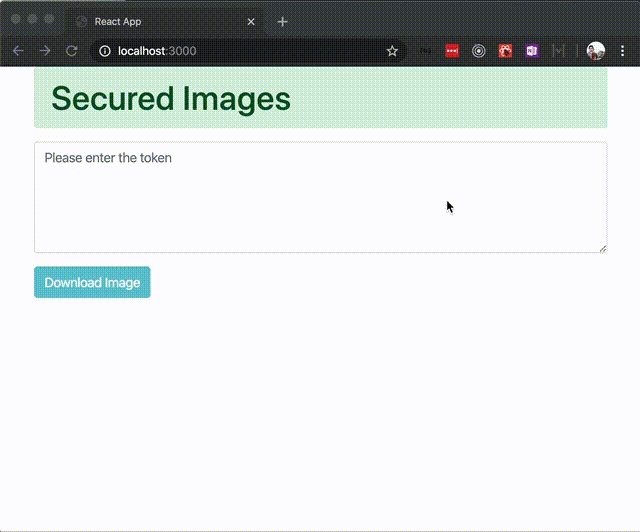Displaying Secured Images
Ran into an interesting problem this week with displaying secured images on the page. The problem is that img tag doesn’t show the image if the resource is secured with a token or a username/password. When the browser encounters an image tag with a secured URL, it’s unable to show the image, so it immediately responds with 401 Unauthorized error because the request is heading towards a protected resource. To show the problem, consider the following endpoint which requires the caller to pass in a token:
// server.js
app.get("/downloadSecuredImage", authentication, (req, res) => {
res.sendFile(`${__dirname}/images/Me.jpg`);
});
As you can see, the Express framework provides a sendFile() method available on the response object which can be used to send static files to the client. It automatically sets appropriate headers to the response. I should also mention the token validation takes place using a custom Express middleware:
const jwt = require("jsonwebtoken");
const database = require("../db/users");
const authentication = async (req, res, next) => {
try {
const token = req.header("Authorization").replace("Bearer ", "");
const decoded = await jwt.verify(token, "SUPER_SECRET_PRIVATE_KEY");
const user = database.users.some((u) => u.email === decoded.user);
if (!user) {
throw new Error("Invalid credentials");
}
req.user = decoded.user;
next();
} catch (exception) {
console.log(exception);
res.status(401).send(exception);
}
};
module.exports = authentication;
Now if we want an img tag to point to that endpoint, we get 401 Unauthorized error, and the result would be the following image:

One solution to tackle this issue is by embedding the image using a particular format. This format is called Data URL, and we can use it inside the image’s src attribute, So the browser does not have to make another request to get it. Here is an example of how such Data URL looks like:
data:image/png;base64,R0lGODlhEAAQAM...
So we’ll need to issue a request of type blob (responseType: "blob") to the protected endpoint with the JWT token provided directly from the code. This way, we don’t need to hard-code the URL inside src attribute anymore. Once the request is completed, we then assign the response data to a variable and make use of FileReader’s readAsDataUrl method to convert the blob result to Base64-encoded string. Here is a React component doing the process:
import React, { useState } from "react";
import axios from "axios";
export default () => {
const [token, setToken] = useState("");
const [image, setImage] = useState<string | ArrayBuffer | null>("");
const downloadImage = async () => {
const img = await axios(`http://localhost:4000/downloadSecuredImage`, {
responseType: "blob",
headers: {
Authorization: `Bearer ${token}`,
},
});
const blob = img.data;
let reader = new FileReader();
reader.readAsDataURL(blob);
reader.onload = () => {
console.log(reader.result);
setImage(reader.result);
};
};
return (
<div className="container">
<div className="row">
<div className="col">
<div className="form-group">
<button
className="btn btn-info"
onClick={(_) => downloadImage()}
disabled={!token}
>
Download Image
</button>
</div>
</div>
</div>
<div className="row">
<div className="col">
<img
src="http://localhost:4000/downloadSecuredImage"
alt="This is a secured image...."
/>
</div>
<div className="col">
{image && <img src={image as string} alt="Image" />}
</div>
</div>
</div>
);
};
Now when the button is clicked we get the file from the server and save the converted result into a state, When the browser encounters the data URL (the value of image), It decodes the data and constructs the original file. This way, we have embedded the image data directly into the document.
